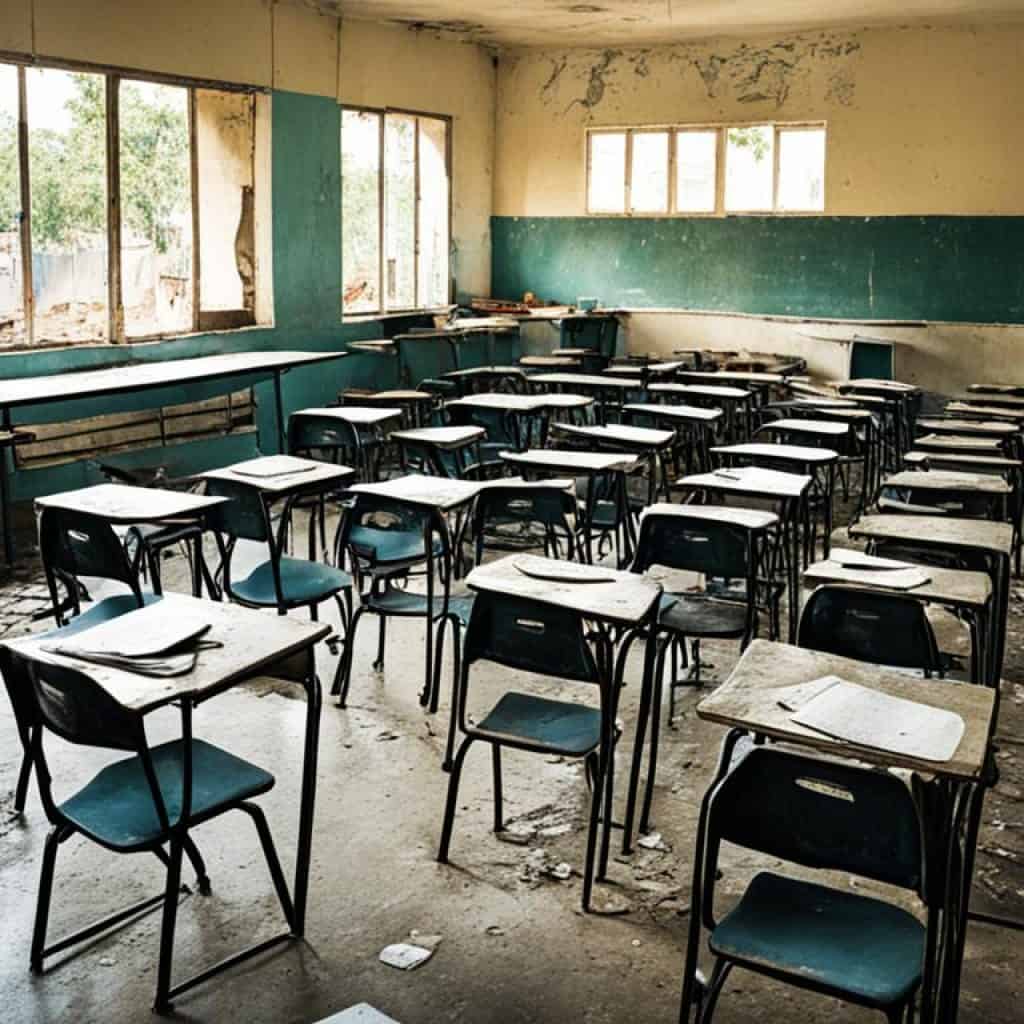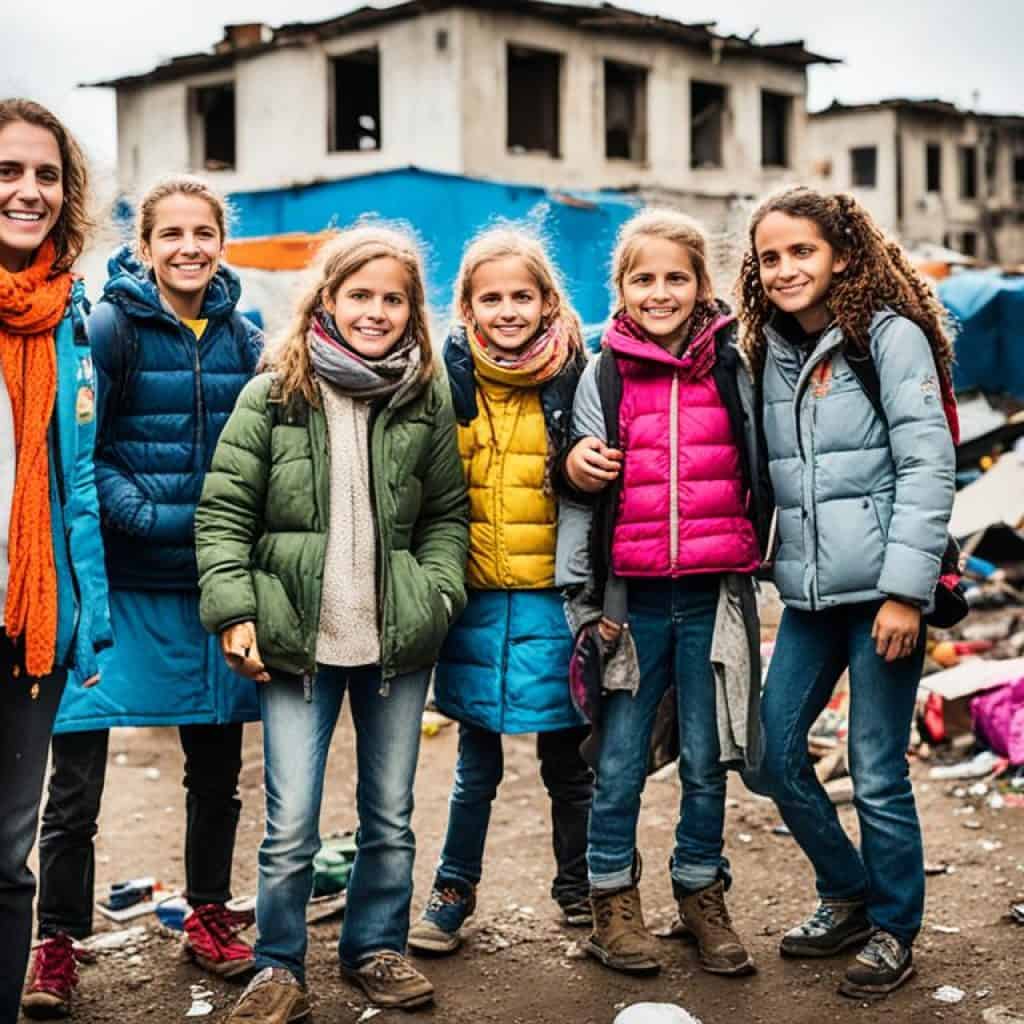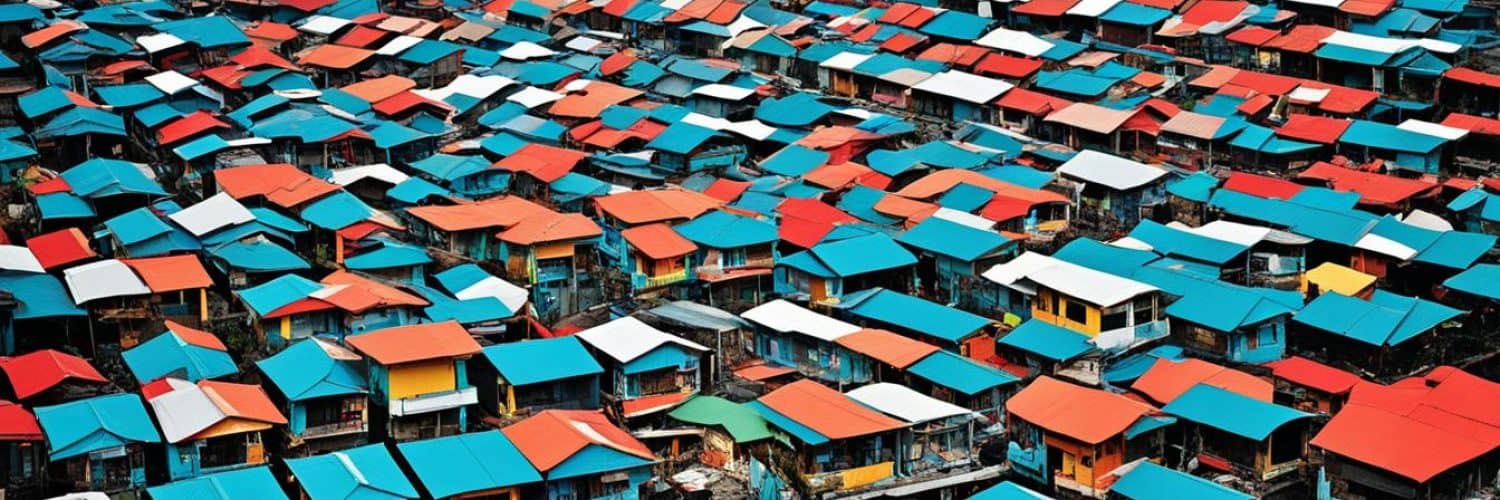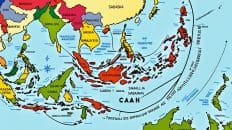Have you ever wondered why income inequality is still a prevalent issue in the Philippines, despite significant progress in poverty reduction?
According to the World Bank, the top 1 percent of earners in the country capture 17 percent of national income, while the bottom 50 percent only share 14 percent. This staggering disparity highlights the urgent need to address social inequalities and promote equal opportunities for all Filipinos.
In this article, we will delve into the impact of economic and social inequality, the relationship between inequality and access to education and healthcare, the challenges to social mobility, and the government’s efforts to reduce inequality. Join us as we uncover the key factors contributing to social inequalities in the Philippines and explore strategies to bridge the gap.
Key Takeaways:
- The Philippines faces high levels of income inequality, with the top 1 percent capturing a significant portion of national income.
- Economic and social inequalities have wide-ranging consequences and hinder progress in poverty reduction.
- Access to education and healthcare plays a crucial role in reducing social inequalities.
- Marginalized communities and disadvantaged populations are particularly affected by social inequalities.
- Government interventions and policies are essential in promoting equal opportunities for all individuals.
The Impact of Economic and Social Inequality in the Philippines
Economic and social inequality in the Philippines have far-reaching consequences for individuals and society as a whole. The persistent issue of poverty not only affects families but also has significant economic ramifications for the country. In fact, the Philippines has one of the highest rates of income inequality in Southeast Asia.
Disparities in land distribution, educational opportunities, vocational training, and basic welfare programs contribute to this inequality. For example, geographical disparities, such as in Mindanao, perpetuate generational poverty, making it challenging for individuals to escape the cycle of poverty. Additionally, the indigenous population faces discrimination and a lack of opportunities, further widening the inequality gap.
Addressing economic and social inequality is crucial for creating a society where everyone has equal access to opportunities and a chance for a better future. Through targeted interventions and policies, the Philippines can work towards reducing poverty, promoting equal educational and vocational opportunities, and creating a more inclusive welfare system.
The Importance of Education in Reducing Inequality
“Education is the most powerful weapon which you can use to change the world.” – Nelson Mandela
Evidence has shown that education plays a pivotal role in reducing social inequalities. By investing in quality education, the Philippines can equip individuals with the knowledge and skills they need to overcome economic disparities and succeed in life. Closing the education gap is crucial in breaking the cycle of poverty and promoting social mobility.
Improving access to quality education for all individuals, regardless of their socio-economic background, is essential. This includes expanding access to secondary and tertiary education, providing scholarships and financial assistance to disadvantaged students, and enhancing the overall quality of education in marginalized communities.
By prioritizing education and creating equal opportunities for all, the Philippines can pave the way towards a more equitable society, where every individual has the chance to thrive and contribute to the nation’s development.
| Impact of Economic and Social Inequality | Educational Disparities | Vocational Training | Basic Welfare Programs |
|---|---|---|---|
| Generational poverty | Limited access to quality education | Insufficient vocational training opportunities | Inadequate support for basic needs |
| High rates of income inequality | Disparities in educational resources | Unequal access to vocational programs | Inequitable distribution of welfare benefits |
| Geographical disparities exacerbate poverty | Discrimination in educational opportunities | Lack of support for skill development | Challenges in accessing vital assistance |
The Relationship Between Inequality and Access to Education
Education is a crucial factor in reducing social inequalities in the Philippines. By providing equal opportunities for all individuals, regardless of their socio-economic background, education can serve as a catalyst for social mobility and empowerment. However, education disparities and barriers to access persist, particularly in marginalized communities, creating a cycle of inequality that hinders progress and upward mobility.
“Education is the most powerful weapon which you can use to change the world.” – Nelson Mandela
Unequal Opportunities: One of the main challenges in addressing education disparities is unequal opportunities. Students from marginalized communities often face limited resources, inadequate infrastructure, and a lack of qualified teachers, hindering their ability to receive a quality education. This perpetuates the gap between the privileged and the marginalized, exacerbating social inequalities.
Slow Access to Tertiary Education: Another factor contributing to education disparities is the slow access to tertiary education for low-income households. The cost of tuition, fees, and living expenses presents a significant barrier for economically disadvantaged students, limiting their ability to pursue higher education. This further widens the gap between the rich and the poor, hindering social mobility and perpetuating inequality.
Inequality in Returns to College Education: While higher education is often seen as a pathway to better job opportunities and higher income, there is still inequality in the returns to college education in the Philippines. Factors such as the prestige and location of educational institutions, as well as social connections, can impact the job prospects and earning potential of graduates. This creates a gap in outcomes for individuals with similar educational qualifications, further exacerbating social inequalities.
Social Norms and Gender Inequality: Social norms and gender inequality also play a role in education disparities. Traditional roles and expectations often place a heavier burden of childcare and household responsibilities on women, limiting their time and resources for education. This perpetuates gender disparities and hinders women’s access to higher education and better job opportunities, impacting social mobility and perpetuating inequality.
Addressing education disparities and promoting equal access to quality education are crucial steps in reducing social inequalities and fostering social mobility in the Philippines. By investing in educational resources, improving infrastructure, providing scholarships and financial aid, and challenging societal norms that perpetuate inequality, we can create a more equitable society where every individual has the opportunity to thrive and succeed.
| Educational Challenges | Impact |
|---|---|
| Unequal opportunities in marginalized communities | Limited access to quality education and resources, perpetuating the cycle of inequality |
| Slow access to tertiary education for low-income households | Restricts opportunities for higher education and social mobility |
| Inequality in returns to college education | Creates disparity in job prospects and earning potential |
| Social norms and gender inequality | Limits women’s access to education and job opportunities, perpetuating gender disparities |
The Role of Healthcare in Addressing Social Inequalities
Access to healthcare plays a crucial role in addressing social inequalities in the Philippines. Marginalized communities, often facing geographic limitations and financial constraints, bear the brunt of inadequate healthcare services. The wealth gap exacerbates disparities in healthcare access, with wealthier individuals enjoying better quality care. To reduce social inequalities, it is imperative to improve healthcare accessibility for all individuals, regardless of their socio-economic status.
Barriers Faced by Marginalized Communities
Marginalized communities, such as indigenous populations and those residing in remote areas, encounter significant barriers when seeking healthcare. These communities often lack proper healthcare facilities and face challenges in transportation, leading to limited access to essential services. Financial constraints further exacerbate the disparity, making it difficult for individuals from marginalized backgrounds to afford necessary medical treatments and medications.
Addressing the Wealth Gap in Healthcare
The wealth gap in the Philippines contributes to unequal access to healthcare services. Affluent individuals have greater financial resources to afford comprehensive medical care, while those from lower income brackets struggle to access even basic healthcare. This disparity perpetuates the cycle of social inequalities, as adequate healthcare is crucial for individuals to lead healthy lives and have equal opportunities for well-being and success.
Improving Accessibility for All
To bridge the gap and reduce social inequalities, efforts must be made to improve healthcare accessibility for all individuals. This includes enhancing healthcare infrastructure in marginalized communities, providing affordable healthcare options, and implementing programs that offer financial assistance for medical services. Initiatives focusing on preventive care, health education, and awareness can contribute to reducing the burden of healthcare disparities and promote equal opportunities for optimal health.
The importance of healthcare accessibility in addressing social inequalities cannot be overstated. By ensuring that every individual has access to quality healthcare services, we take significant strides towards creating a more equitable society.
| Barriers to Healthcare Access | Solutions to Address Inequalities |
|---|---|
| Geographic limitations | Enhance healthcare infrastructure in remote and marginalized areas, establish mobile healthcare units |
| Financial constraints | Implement health insurance schemes, provide subsidies for medical treatments and medications |
| Lack of awareness | Conduct health education programs, disseminate information about available healthcare services |
By addressing the barriers faced by marginalized communities and closing the healthcare accessibility gap, we can work towards reducing social inequalities in the Philippines. Health is a fundamental human right, and it is essential to ensure that every individual, regardless of their socio-economic status, has equal access to quality healthcare services.
Challenges to Social Mobility in the Philippines
Social mobility, the ability of individuals to move up the social ladder, is a key indicator of social equality. In the Philippines, there are significant challenges to social mobility, particularly for individuals from marginalized communities and those facing economic disparities. Limited access to quality education, lack of job opportunities, and systemic inequalities hinder upward mobility, trapping individuals in cycles of poverty. Addressing these challenges requires targeted policies and interventions that promote equal opportunities for all.
Education Disparities and Social Mobility
The limited access to quality education in marginalized communities perpetuates social inequalities and hinders social mobility. Many individuals in these communities face inadequate educational resources, overcrowded schools, and a lack of qualified teachers. These disparities create barriers for students to acquire the necessary skills and knowledge to succeed in higher education and secure well-paying jobs. Bridging the education gap is crucial to promoting social mobility and breaking the cycle of poverty.
Economic Disparities and Opportunities
The presence of economic disparities in the Philippines creates a significant hurdle for social mobility. Many individuals from impoverished backgrounds struggle to find stable and well-paying jobs that can provide upward mobility. The lack of job opportunities, particularly in marginalized communities, further exacerbates the economic disparities that hinder social mobility. Creating more employment opportunities, especially in marginalized areas, and implementing policies that promote inclusive economic growth are essential for fostering social mobility.
Systemic Inequalities and Social Mobility
The presence of systemic inequalities poses a significant challenge to social mobility in the Philippines. Discrimination based on factors such as gender, ethnicity, and socio-economic status limits opportunities for individuals from marginalized communities to advance in society. Addressing these systemic inequalities requires dismantling discriminatory practices, promoting equal access to resources and opportunities, and fostering inclusive policies and institutions.
“Social mobility is not just about personal success but also about building a more inclusive and equitable society where everyone has an opportunity to thrive.”
To overcome these challenges to social mobility, the Philippines needs comprehensive strategies that prioritize equal access to quality education, create employment opportunities, and address systemic inequalities. By investing in education, improving job prospects, and fostering an environment that promotes equal opportunities, the country can break the cycle of poverty, reduce economic disparities, and pave the way for a more socially mobile and equitable society.

| Challenges | Impact on Social Mobility |
|---|---|
| Limited access to quality education | Hinders acquisition of necessary skills for upward mobility |
| Lack of job opportunities | Limits economic advancement and upward mobility |
| Systemic inequalities | Creates barriers for individuals from marginalized communities to progress |
Understanding the Wealth Gap in the Philippines
The wealth gap in the Philippines is a significant contributor to social inequalities. The top 1 percent of earners capture a disproportionate amount of national income, while a large portion of the population struggles with poverty. This concentration of wealth in the hands of a few exacerbates economic disparities and limits opportunities for social mobility.
“The concentration of wealth and lack of economic opportunity create a stark contrast between the rich and the poor in the Philippines. This inequality hinders progress and perpetuates a cycle of poverty that is difficult to break.”
To address these social inequalities, it is crucial to bridge the wealth gap and ensure a more equitable distribution of resources and opportunities. This requires implementing policies that aim to reduce income disparities and promote inclusive growth.
The Impact of the Wealth Gap
The wealth gap in the Philippines has far-reaching consequences for individuals and society. It widens the divide between the rich and the poor, limiting access to essential services such as education, healthcare, and housing for those at the bottom of the economic ladder. Economic disparities resulting from the wealth gap also hinder social mobility, making it harder for individuals to escape the cycle of poverty and improve their life circumstances.
“The wealth gap in the Philippines not only affects individuals and families but also has broader implications for the country’s overall development. It hampers economic growth and stability, as a significant portion of the population is unable to contribute fully to the economy due to the lack of opportunities.”
Addressing the Wealth Gap
Closing the wealth gap requires a multi-faceted approach that addresses the root causes of economic disparities. This includes implementing policies that promote equitable taxation, redistribute wealth, and provide equal access to education and healthcare. Targeted interventions, especially for marginalized communities and vulnerable groups, can empower individuals and create a more inclusive society.
“By reducing the wealth gap, we can create a fairer society where everyone has the opportunity to thrive and contribute to the nation’s progress. It is an essential step towards reducing poverty and building a more sustainable and equitable future for the Philippines.”
Only by addressing the wealth gap and tackling economic disparities can the Philippines work towards reducing social inequalities and creating a society that provides equal opportunities for all.
The Impact of COVID-19 on Social Inequalities
The COVID-19 pandemic has had a profound impact on social inequalities in the Philippines. The economic downturn caused by the pandemic has not only reversed decades-long progress in poverty reduction but has also exacerbated existing income disparities in the country. Despite government assistance, the national poverty rate rose to 18.1 percent in 2021, highlighting the devastating effects of the pandemic on vulnerable communities.
The COVID-19 crisis has disproportionately affected the poorest individuals and families, leading to increased unemployment and food insecurity. The closure of businesses and loss of jobs have left many struggling to make ends meet, pushing them further into poverty. The lack of access to essential resources and services has widened the gap between the rich and the poor, perpetuating existing economic disparities.
Recovery efforts must prioritize the specific needs of the most vulnerable populations, particularly those living in poverty. Comprehensive strategies that address the widening gaps caused by the pandemic are essential for reducing social inequalities and ensuring a more equitable society for all Filipinos. This includes targeted interventions to support income generation, job creation, and access to basic necessities such as food, healthcare, and education.
Tackling Inequality of Opportunity in the Philippines
Inequality of opportunity is a significant contributor to social inequalities in the Philippines. The disparities in access to essential resources, such as quality education and healthcare, begin before birth and persist throughout an individual’s life. Marginalized communities, in particular, face systemic barriers that limit their access to social and economic opportunities, exacerbating the inequality gap.
To combat this issue, targeted interventions are necessary to increase access to crucial services for disadvantaged populations. These interventions must focus on improving the quality of education, expanding healthcare coverage, and providing other essential services to marginalized communities.
- Improving Access to Education: Enhancing access to quality education is crucial in closing the inequality gap. This includes providing equal opportunities for all individuals, regardless of their socio-economic status, and addressing disparities in educational resources, facilities, and teaching quality.
- Expanding Healthcare Coverage: Ensuring that healthcare is accessible and affordable to all is vital for reducing inequality. This involves improving healthcare infrastructure, expanding health insurance coverage, and implementing targeted programs to address the healthcare needs of marginalized communities.
- Promoting Equal Opportunities: Breaking down systemic barriers and creating equal opportunities for all individuals is essential. This includes addressing discrimination, providing vocational training, supporting entrepreneurship, and implementing policies that promote inclusivity and diversity.
By prioritizing these interventions and focusing on reducing the inequality of opportunity, the Philippines can move towards a more equitable society, where individuals from all backgrounds have equal access to resources and opportunities for personal and economic growth.
Quote:
“Equal opportunity means more than equal opportunity to succeed; it means an equal opportunity to strive for personal success and to contribute to the common good. It means an equal chance to fulfill one’s potential regardless of where one starts in life.”
Policy Priorities to Reduce Inequality in the Philippines
Addressing social inequalities requires a multi-faceted approach and policy interventions. To reduce inequality in the Philippines, the World Bank report suggests three key policy themes:
- Healing the scars of the pandemic and building resilience: It is essential to prioritize measures that boost vaccine uptake, overcome learning loss, strengthen social assistance, and provide unemployment insurance programs. By focusing on these areas, the country can recover from the impact of the pandemic and create a more resilient society.
- Promoting a vibrant and inclusive recovery: To reduce inequality, policymakers should prioritize reskilling programs, entrepreneurship initiatives, and women’s participation in the workforce. Additionally, increasing productivity in agriculture can create more job opportunities and contribute to a more inclusive economy.
- Promoting greater equality of opportunity: Improving access to quality healthcare and education is crucial for reducing inequality. Policymakers should address housing disparities and work towards ensuring that all individuals have equal opportunities to access essential services and opportunities.
By focusing on these policy priorities, the Philippines can make significant strides in reducing inequality and building a more equitable society for all its citizens.
| Policy Priority | Description |
|---|---|
| Healing the scars of the pandemic and building resilience | Boost vaccine uptake, overcome learning loss, strengthen social assistance, and provide unemployment insurance programs |
| Promoting a vibrant and inclusive recovery | Emphasize reskilling programs, entrepreneurship initiatives, women’s participation in the workforce, and increased productivity in agriculture |
| Promoting greater equality of opportunity | Improve access to quality healthcare and education, address housing disparities |
Overcoming Unfair Distribution of Wealth
The unequal distribution of wealth in the Philippines has created an unfair system that favors those who are already privileged. The scale of opportunities, from birth to adulthood, is heavily tilted towards those with more resources, perpetuating the cycle of income inequality. To address this issue, there is a need for stronger public accountability and good governance that prioritize the needs of the people, especially in terms of essential services like health, social protection, and nutrition.
Reducing inequality requires concerted efforts to create a more equitable society for all Filipinos. By implementing policies that promote wealth redistribution and ensure access to essential services for all, the Philippines can eradicate social inequalities and foster a society where everyone has the opportunity to thrive.
Key Strategies to Overcome Unfair Distribution of Wealth
The following strategies can play a crucial role in addressing the unfair distribution of wealth and reducing social inequalities in the Philippines:
- Implement progressive tax systems that require higher contributions from wealthy individuals and corporations, redirecting these resources towards social programs that benefit the less privileged.
- Strengthen social safety nets to provide financial assistance and support for individuals and families in need, helping to alleviate poverty and bridge the wealth gap.
- Invest in quality education for all, particularly in disadvantaged communities, to provide equal opportunities for upward mobility and break the cycle of intergenerational poverty.
- Facilitate access to affordable housing and improve living conditions in marginalized areas, ensuring that everyone has a safe and conducive environment to thrive.
- Promote inclusive economic policies that prioritize the growth of small and medium-sized enterprises, fostering entrepreneurship and creating job opportunities for all.
- Enhance transparency and accountability in government spending, ensuring that resources are channeled towards programs and initiatives that benefit the most vulnerable populations.
By adopting these strategies and addressing the root causes of unfair distribution of wealth, the Philippines can pave the way for a more just and equitable society, where social inequalities are minimized and everyone has an equal chance to succeed.
| Indicators | Current Situation | Target |
|---|---|---|
| Income Gini Coefficient | 42.3% | 30% or lower |
| Share of National Income by Top 1% | 17% | 10% or lower |
| Share of National Income by Bottom 50% | 14% | 20% or higher |
The Importance of Education and Healthcare in Reducing Inequality
Education and healthcare are crucial factors in reducing social inequalities in the Philippines. Access to quality education ensures equal opportunities for individuals, regardless of their socio-economic background. By investing in education, particularly at the secondary and tertiary levels, we can narrow the gap between the privileged and the marginalized, promoting social mobility and breaking the cycle of poverty.
Similarly, improving access to healthcare and ensuring quality healthcare services for all contribute to reducing health disparities and addressing social inequalities. By providing equal access to healthcare, we can ensure that every individual, regardless of their socio-economic status, receives the care they need to lead healthy and productive lives.
Policies and interventions that prioritize education and healthcare are essential in creating a more equitable society in the Philippines. By addressing education disparities and improving access to healthcare, we can empower individuals and communities, create equal opportunities for all, and contribute to the overall well-being and development of the nation.
Education Disparities in the Philippines
Education disparities in the Philippines are a significant challenge in reducing social inequalities. Marginalized communities, particularly those in remote areas, face limited access to quality education and resources, perpetuating the cycle of poverty. It is crucial to implement targeted interventions, such as improving infrastructure and increasing funding for schools in underserved areas, providing scholarships and financial assistance to low-income students, and enhancing teacher training programs to ensure equal educational opportunities for all.
The Role of Healthcare in Addressing Social Inequalities
Access to healthcare is a fundamental right that should be available to all individuals, regardless of their socio-economic status. Marginalized communities often face barriers to healthcare, such as geographic location and financial constraints. To address social inequalities, it is essential to improve healthcare infrastructure in underserved areas, increase the availability of healthcare professionals, and provide financial assistance for those who cannot afford medical expenses. Prioritizing healthcare access and quality services will help reduce disparities and improve the overall health and well-being of the population.
| Benefit of Education | Benefit of Healthcare |
|---|---|
| Promotes equal opportunities | Reduces health disparities |
| Enables social mobility | Improves overall population health |
| Breaks the cycle of poverty | Enhances productivity and economic growth |
| Empowers individuals and communities | Promotes well-being and quality of life |
Investments in education and healthcare are vital in reducing social inequalities in the Philippines. By providing equal opportunities for quality education and accessible healthcare services, we can create a more equitable society that empowers individuals and promotes the well-being and development of the nation.
Quote:
The path to a more equitable society begins with equal access to education and healthcare for all individuals. By prioritizing these areas, we can address social inequalities and build a stronger, more inclusive Philippines.
Breaking the Cycle of Poverty through Education
Education is a powerful tool in breaking the cycle of poverty. By providing quality education to all individuals, regardless of their socio-economic background, it becomes possible to transform lives and promote social mobility. Investing in education, particularly for marginalized communities and low-income households, can create opportunities for upward mobility and help individuals escape the cycle of poverty.
Expanding access to secondary and tertiary education is crucial in reducing education disparities and providing equal opportunities for all. By ensuring that students have the chance to pursue higher education, we can empower them to acquire the knowledge and skills needed to succeed in the job market and improve their economic and social well-being.
Financial assistance, such as scholarships and grants, plays a vital role in enabling students from low-income households to pursue education without the burden of overwhelming debt. These support programs can help bridge the affordability gap and ensure that talented individuals from disadvantaged backgrounds have a fair chance to access quality education.
Improving the quality of education is equally important in reducing social inequalities. By enhancing the curriculum, training competent teachers, and providing adequate resources to schools in underprivileged areas, we can ensure that all students receive the education they deserve, regardless of their circumstances.
Education is the passport to the future, for tomorrow belongs to those who prepare for it today. – Malcolm X
Breaking the cycle of poverty through education is not only essential for individual well-being but also for the overall development and prosperity of the Philippines. When we provide equal access to education and promote social mobility, we create a more just and equitable society.

Government Efforts to Reduce Inequality of Opportunity
The Filipino government recognizes the importance of addressing social inequalities and has implemented various efforts to reduce the inequality of opportunity in the country. These initiatives focus on expanding access to healthcare services, promoting equality in education, and improving housing conditions.
To ensure that all individuals have access to quality healthcare, the government has been working towards enhancing healthcare infrastructure and services. This includes the establishment of healthcare facilities in underserved areas and the implementation of programs that provide free or affordable healthcare to marginalized communities. By improving access to healthcare, the government aims to reduce health disparities and give everyone an equal chance at a healthy life.
Another crucial aspect of reducing inequality of opportunity is promoting equal access to education. The government has been investing in improving the quality of education and expanding educational opportunities for all Filipinos. Initiatives such as scholarship programs, school infrastructure development, and teacher training aim to ensure that no one is left behind due to financial constraints or limited educational resources. Through these efforts, the government seeks to create a level playing field where everyone has an equal chance to acquire knowledge and skills.
Furthermore, addressing housing disparities is a key priority in reducing inequality of opportunity. The government has been implementing housing programs that aim to provide affordable and decent housing to low-income families. These programs focus on urban and rural areas, with initiatives such as socialized housing projects and community-based development programs. By improving access to quality housing, the government aims to improve the living conditions of marginalized communities and create an environment conducive to growth and upward mobility.
Through these government efforts, the Philippines is taking significant steps towards reducing inequality of opportunity. By expanding access to healthcare services, promoting equality in education, and improving housing conditions, the government seeks to create a society where everyone has a fair chance at success and well-being.
The Importance of Building Resilience and Healing from the Pandemic
The COVID-19 pandemic has had a profound impact on societies worldwide, revealing and exacerbating existing social inequalities. In the Philippines, the pandemic has brought to light the urgent need to build resilience and address the underlying factors that contribute to these inequalities.
As the country strives to recover from the effects of the COVID-19 pandemic, it is essential to focus on several key areas to reduce inequality and build resilience. First and foremost, promoting vaccine uptake is crucial in protecting the population from the virus and preventing further outbreaks. Vaccination programs can help mitigate the disproportionate impact of the pandemic on vulnerable communities and reduce health disparities.
Overcoming learning loss is another critical aspect to address, as disruptions to education have disproportionately affected disadvantaged students. By implementing targeted interventions such as remedial education programs and expanding access to remote learning technologies, the education gap can be narrowed, ensuring that all students have equal opportunities to succeed.
“The pandemic has further highlighted the importance of strengthening social assistance programs and safety nets to support those most affected by the crisis.”
Strengthening social assistance programs, such as cash transfers and food assistance initiatives, is vital in providing support to individuals and families facing economic hardships. These programs can help mitigate the impact of unemployment and income loss, reducing inequality and promoting social well-being.
Addressing unemployment issues is also crucial for building resilience and reducing inequality. By creating opportunities for employment, particularly in sectors heavily impacted by the pandemic, individuals and communities can recover economically and rebuild their lives.
By building resilience in the face of future challenges and focusing on reducing inequality, the Philippines can strive towards a more equitable and inclusive society. Through targeted interventions and a comprehensive approach that addresses the underlying factors contributing to social inequalities, the country can emerge stronger from the pandemic and create a better future for all Filipinos.
Key Strategies to Reduce Inequality and Build Resilience:
- Promoting vaccine uptake and ensuring equitable access to vaccination programs.
- Addressing learning loss through remedial education programs and expanded access to remote learning technologies.
- Strengthening social assistance programs and safety nets to support those most affected by the pandemic.
- Creating employment opportunities in sectors heavily impacted by the pandemic.
By implementing these strategies and prioritizing equity and inclusivity, the Philippines can not only recover from the COVID-19 pandemic but also build a more resilient society that reduces inequality and ensures the well-being of all its citizens.
Promoting Equal Opportunities for All
Promoting equal opportunities for all individuals is crucial in reducing social inequalities in the Philippines. This requires addressing systemic barriers and disparities in access to education, healthcare, and other essential services. By prioritizing marginalized communities and disadvantaged populations, targeted interventions can help level the playing field and provide equal opportunities for all.
Addressing Systemic Barriers
Systemic barriers, such as poverty, discrimination, and lack of resources, contribute to the perpetuation of social inequalities. To promote equal opportunities, it is essential to identify and address these barriers. Targeted policies and programs can help bridge the gap and create a more inclusive society.
“Equal opportunities are not about providing everyone with the same resources and support. It’s about understanding the unique challenges faced by different individuals and communities and providing tailored solutions to ensure everyone has an equitable chance at success.” – Maria Santos, Social Equality Advocate
By focusing on the needs of marginalized communities and disadvantaged populations, we can work towards breaking the cycle of inequality and creating a level playing field for all Filipinos.
Reducing Disparities in Access
Equal opportunities require equal access to essential services such as education and healthcare. Unfortunately, marginalized communities often face significant disparities in accessing these services. By investing in infrastructure, improving transportation networks, and expanding healthcare facilities, we can reduce the barriers that hinder access for disadvantaged populations.

Furthermore, providing financial support, scholarships, and vocational training can help individuals from marginalized communities overcome economic barriers and gain access to educational opportunities. Breaking down these access barriers is essential in reducing inequality and promoting equal opportunities for all.
Empowering Marginalized Communities
To truly promote equal opportunities, it is crucial to empower marginalized communities. This can be done through community-based initiatives, capacity-building programs, and advocacy for representation and inclusion. By empowering individuals and communities, we can foster a sense of agency, resilience, and self-determination.
List of initiatives to empower marginalized communities:
- Entrepreneurship training and microfinance support
- Skills development programs tailored to the needs of specific communities
- Representation and inclusion in decision-making processes
- Access to legal services and protection of rights
By promoting equal opportunities and empowering marginalized communities, we can reduce social inequalities and build a more equitable society in the Philippines.
| Benefits of Promoting Equal Opportunities | Actions to Promote Equal Opportunities |
|---|---|
| Reduction in income inequality | Investment in education and vocational training |
| Increase in social mobility | Targeted policies for marginalized communities |
| Improvement in overall health and well-being | Expansion of healthcare facilities in underserved areas |
| Enhanced economic growth and productivity | Support for entrepreneurship and small businesses |
Conclusion
Social inequalities continue to persist in the Philippines, characterized by income disparities, limited access to quality education, healthcare, and systemic barriers that impede social mobility. However, there is hope for reducing these inequities and fostering a more just and equitable society.
Investing in education is crucial for breaking the cycle of poverty and promoting equal opportunities. By expanding access to quality education, particularly for marginalized communities, we can provide individuals with the tools they need to succeed and improve their socio-economic status. Additionally, improving access to healthcare for all individuals, regardless of their socio-economic background, is essential in reducing health disparities and promoting well-being.
To address economic disparities, it is important to tackle the wealth gap and ensure a more equitable distribution of resources. Implementing targeted policies that prioritize the needs of disadvantaged populations and promoting inclusive economic growth can help reduce the inequality gap in the Philippines.
By embracing these strategies and working collaboratively, we can pave the way for a society where social inequalities are minimized, economic disparities are reduced, and all individuals have equal opportunities to thrive. Together, let us strive towards building a more inclusive and equitable future for the Philippines.
FAQ
What is the impact of economic and social inequality in the Philippines?
How does inequality affect access to education in the Philippines?
What role does healthcare play in addressing social inequalities in the Philippines?
What are the challenges to social mobility in the Philippines?
How does the wealth gap contribute to social inequalities in the Philippines?
What is the impact of the COVID-19 pandemic on social inequalities in the Philippines?
How does inequality of opportunity contribute to social inequalities in the Philippines?
What policy priorities can help reduce inequality in the Philippines?
How can the unfair distribution of wealth be addressed in the Philippines?
What is the importance of education and healthcare in reducing inequality?
How can education break the cycle of poverty in the Philippines?
What is the role of the government in reducing inequality of opportunity in the Philippines?
How important is building resilience and healing from the pandemic in reducing inequality?
Why is promoting equal opportunities important in reducing social inequalities?
Source Links
- https://www.worldbank.org/en/news/press-release/2022/11/24/ph-reducing-inequality-key-to-becoming-a-middle-class-society-free-of-poverty
- https://www.childfund.org/stories-and-news/2013/july/closing-the-social-inequality-gap-in-the-philippines/
- https://opinion.inquirer.net/159445/addressing-inequality-in-the-philippines














Add comment